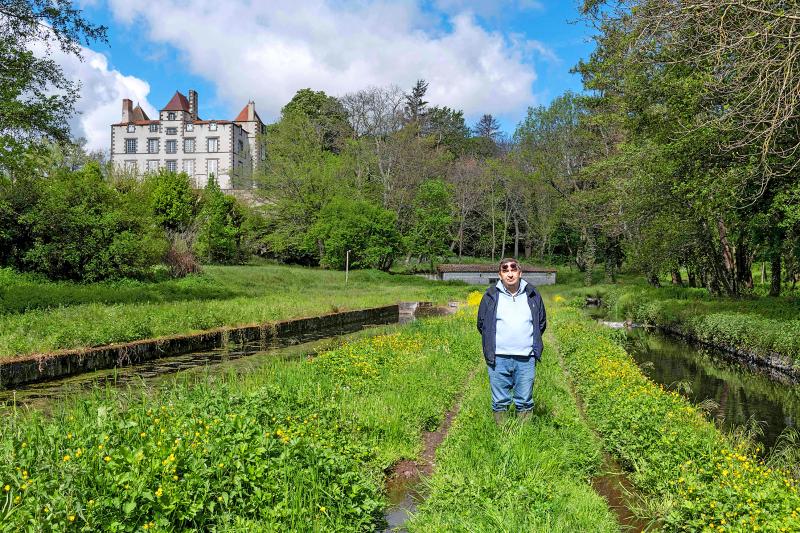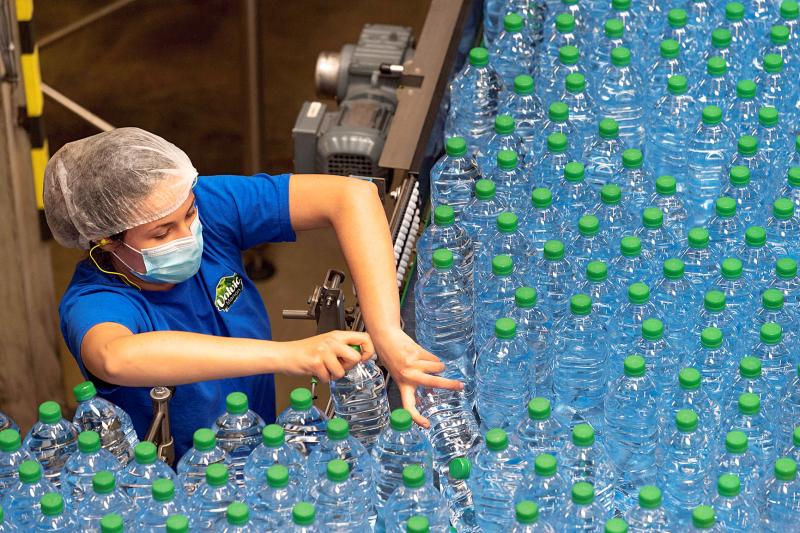The lush volcanic hills surrounding Volvic in central France have long been a source of mineral water prized worldwide, but locals and geologists warn that too much is now being pumped out, putting the entire region at risk.
“We used to have water up to our knees and the stream could turn two mills,” said Pierre Grodecoeur, 69, pointing out the flow outside the house where he was born in Les Moulins Blancs.
The mills are long gone, Grodecoeur said, and these days the stream bed is often dry.

Photo: AFP
His village in the Auvergne region is just down the road from the hulking Volvic bottling plant owned by French food and beverage giant Danone SA.
Since 2014, the government has allowed Danone to bottle up to 2.8 million cubic meters a year — or 2.8 billion one-liter bottles.
That translates into an extraction of nearly 89 liters per second from the Volvic water table, compared with just 15.6 liters when bottling operations first began in 1965.

Photo: AFP
Yet at the nearby fish hatchery of Saint-Genest-l’Enfant, a registered landmark dating from the 17th century where the Volvic source naturally emerges, there are now some months when no water flows at all. The owner, Edouard de Feligonde, had to shut down the fishery a few years ago after duckweed formed slick green films over basins that became stagnant due to a lack of current.
“Danone is destroying a historical monument so that it can send its bits of plastic to the other side of the world,” said Feligonde, who is waging a legal battle against the multinational with lawyer and former French minister of the environment Corinne Lepage.
Geologist Robert Durand said the average flow rate at the Volvic source had fallen to 50 liters per second, far below the 470 liters per second recorded in 1927.
Water shortages are already affecting the region’s biodiversity by reducing the natural humidity of the forested hills.
“It can be described as the beginning of a desertification,” said Christian Amblard, an expert with the French National Centre for Scientific Research in Clermont-Ferrand, the historic capital of Auvergne.
He cited declines in black alder trees and the siskin songbirds that nest in them, and in ash trees and golden orioles.
“Only the hand of man and Volvic are responsible,” he said.
Laurent Campos-Hugueney, a farmer and member of the Water is a Public Good collective, said streams around Volvic no longer flow strongly enough to support irrigation.
“There hasn’t been any plant or vegetable operations in the area for several years,” he said.
However, Jerome Gros, director at the Volvic bottling site, disputed the claim that his operations are sucking the waterbed dry, and said that Danone is investing heavily in protecting the source.
“We have saved 380 million liters between 2017 and 2020 even as sales remained stable,” Gros said.
In 2014, for example, Volvic needed to pump out two liters to fill a one-liter bottle, with the excess used for sterilizing and rinsing equipment. “Today we’re down to just 1.4 liters for every liter bottled,” he said.
Critics are not convinced, saying that Volvic pumps up water from up to 100m deep, and that stream depletions cannot be ascribed to the weather as rainfall has remained steady over the years.
“It’s like you’re emptying a bathtub from the bottom,” said Francois-Dominique de Larouziere, a geologist who is member of the local Preva environmental preservation group.
Authorities have also allowed Volvic to spread its volume allotment over the entire year, meaning it can pump more in summer when demand spikes, leaving everyone else high and dry.
The government’s top official for the region, Philippe Chopin, last month told a parliamentary commission that “environmental conditions, in particular drought, caused a drop in the aquifer that we do not believe can be blamed” on Volvic’s extractions.
His assertions were rejected by many at Volvic, where the issuance of building permits was halted in August last year due to a risk of drinking water shortages — although the mayor denied any proof that Volvic’s operations were the cause.
“How can you tell people they can’t water three tomato plants in the middle of summer, when they see full trucks leaving this factory?” De Larouziere said. “Danone is shooting itself in the foot, but when the faucet stops running, it’s going to be painful.”

IN THE AIR: While most companies said they were committed to North American operations, some added that production and costs would depend on the outcome of a US trade probe Leading local contract electronics makers Wistron Corp (緯創), Quanta Computer Inc (廣達), Inventec Corp (英業達) and Compal Electronics Inc (仁寶) are to maintain their North American expansion plans, despite Washington’s 20 percent tariff on Taiwanese goods. Wistron said it has long maintained a presence in the US, while distributing production across Taiwan, North America, Southeast Asia and Europe. The company is in talks with customers to align capacity with their site preferences, a company official told the Taipei Times by telephone on Friday. The company is still in talks with clients over who would bear the tariff costs, with the outcome pending further

A proposed 100 percent tariff on chip imports announced by US President Donald Trump could shift more of Taiwan’s semiconductor production overseas, a Taiwan Institute of Economic Research (TIER) researcher said yesterday. Trump’s tariff policy will accelerate the global semiconductor industry’s pace to establish roots in the US, leading to higher supply chain costs and ultimately raising prices of consumer electronics and creating uncertainty for future market demand, Arisa Liu (劉佩真) at the institute’s Taiwan Industry Economics Database said in a telephone interview. Trump’s move signals his intention to "restore the glory of the US semiconductor industry," Liu noted, saying that

NEGOTIATIONS: Semiconductors play an outsized role in Taiwan’s industrial and economic development and are a major driver of the Taiwan-US trade imbalance With US President Donald Trump threatening to impose tariffs on semiconductors, Taiwan is expected to face a significant challenge, as information and communications technology (ICT) products account for more than 70 percent of its exports to the US, Chung-Hua Institution for Economic Research (CIER, 中華經濟研究院) president Lien Hsien-ming (連賢明) said on Friday. Compared with other countries, semiconductors play a disproportionately large role in Taiwan’s industrial and economic development, Lien said. As the sixth-largest contributor to the US trade deficit, Taiwan recorded a US$73.9 billion trade surplus with the US last year — up from US$47.8 billion in 2023 — driven by strong

STILL UNCLEAR: Several aspects of the policy still need to be clarified, such as whether the exemptions would expand to related products, PwC Taiwan warned The TAIEX surged yesterday, led by gains in Taiwan Semiconductor Manufacturing Co (TSMC, 台積電), after US President Donald Trump announced a sweeping 100 percent tariff on imported semiconductors — while exempting companies operating or building plants in the US, which includes TSMC. The benchmark index jumped 556.41 points, or 2.37 percent, to close at 24,003.77, breaching the 24,000-point level and hitting its highest close this year, Taiwan Stock Exchange (TWSE) data showed. TSMC rose NT$55, or 4.89 percent, to close at a record NT$1,180, as the company is already investing heavily in a multibillion-dollar plant in Arizona that led investors to assume